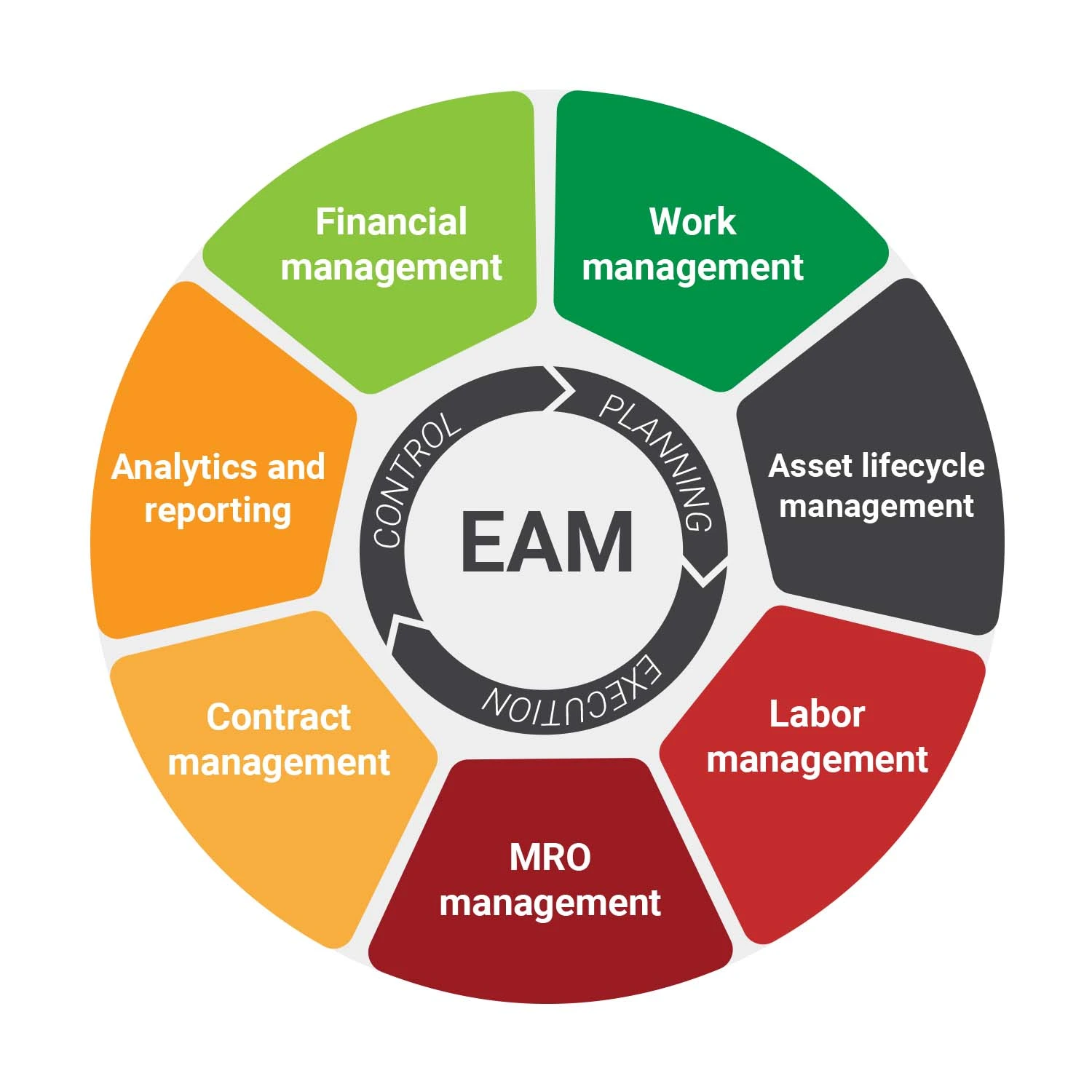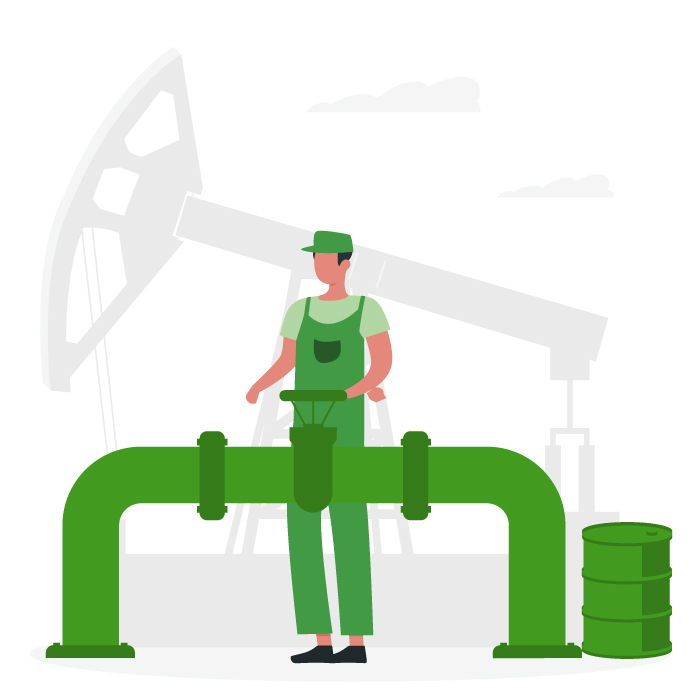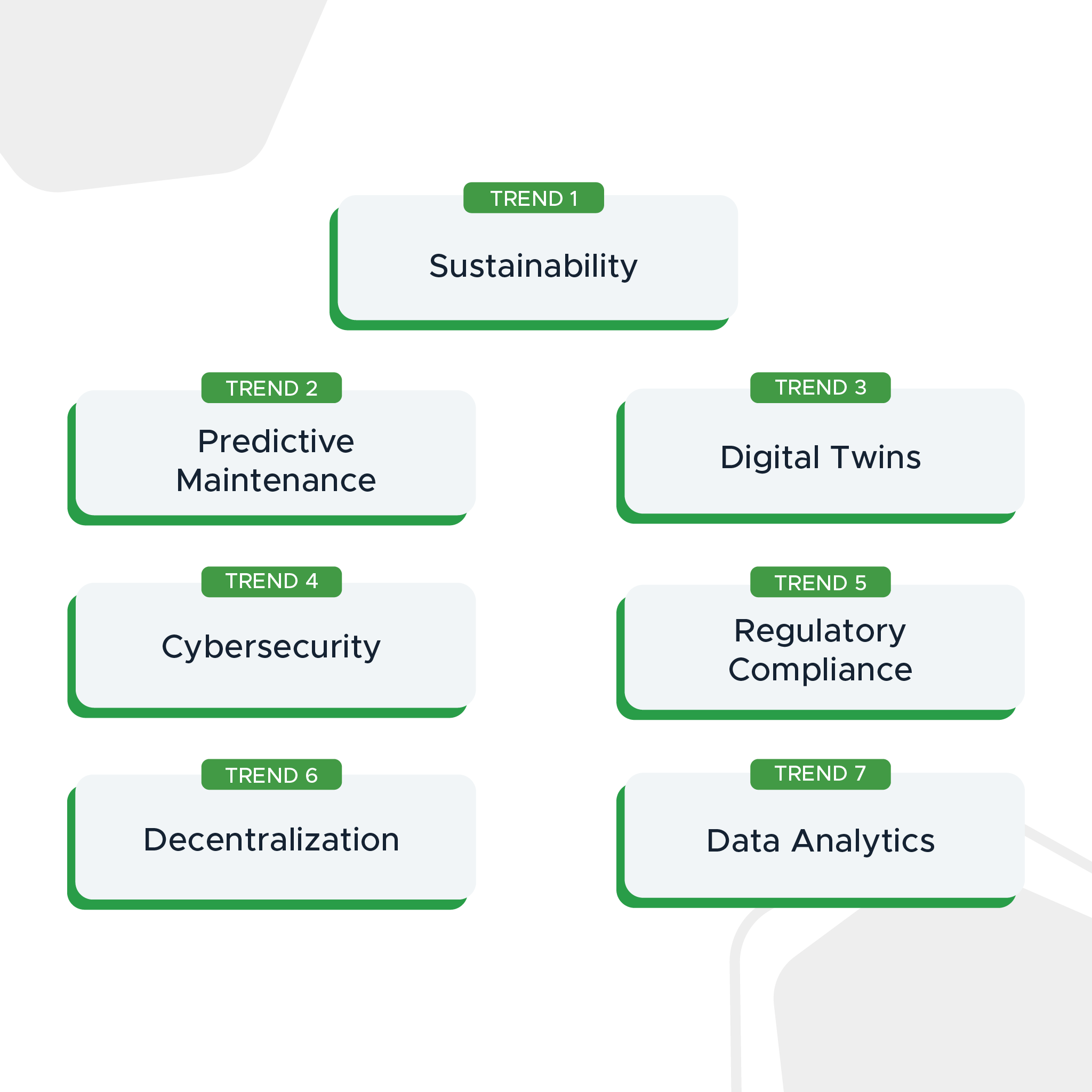Utility Asset Management
Learn how effective utility asset management can help energy and utility companies ensure reliable and cost-effective service.
What is utility asset management??
Utility asset management is the strategic process of managing the physical assets and infrastructure involved in delivering utility services. It ensures cost-effective and systematic methods for managing all stages of the equipment lifecycle including procurement, installation, upgrades, maintenance, and disposal.
Asset management is now estimated to be a 5 billion dollar industry. A successful comprehensive asset management strategy includes various key functions to help address the utility industry’s most significant challenges.
Asset management challenges facing utility companies
Utilities face many of the same challenges that impact other industries, but with direct consequences for consumers when things go awry. Some of the top challenges affecting utility efficiency and effectiveness are:
- Aging infrastructure: Lack of sufficient public or private infrastructure leads to increased costs for maintenance and logistics and a pressing need for modernization.
- Regulatory compliance: Utilities must navigate numerous local, national, and international regulations – a complex and resource-intensive task.
- Environmental concerns: Utilities face a growing awareness of the need to reduce carbon emissions, manage waste sustainably, and adhere to stringent environmental regulations.
- Transport electrification: Utilities must adapt their infrastructure and logistics to accommodate the increasing electrification of the transportation system.
A strategic approach to asset management, supported by the right tools and software, is instrumental in addressing these challenges.
Types of utilities that need asset management
Many different services and companies fall within the utility industry. Each has its own unique set of asset management needs and concerns.
Water utilities
Water utilities supply clean water for drinking, sanitation, and industry while managing wastewater and stormwater. They ensure the health and well-being of community members and the environment.
Here are some common asset management challenges they face:
- Continuity of water and wastewater treatment functions: Continuous operation of the equipment that performs water treatment functions allows no room for error. It requires multiple redundancies and the tools, resources, and spare parts to execute emergency maintenance procedures quickly.
- Pipeline integrity and leak management: The extensive network of pipes for water distribution and sewage collection requires constant monitoring and maintenance to prevent leaks, breaks, and contamination.
- Asset information infrastructure: Quick and easy access to asset data, spare parts information, and standard operating procedures enable critical processes from compliance to emergency maintenance.
- Resource conservation and sustainability: Water conservation and sustainable management strategies are required, especially in areas facing water scarcity or quality issues.
- Technological evolution: Advanced technologies such as smart meters, remote sensors, and GIS (Geographic Information Systems) offer opportunities for better system monitoring, leak detection, and infrastructure management when used strategically.
Effective water asset management requires rigorous and efficient proactive maintenance programs for treatment facilities, pipelines, and other critical infrastructure. Embracing a data-driven approach to maintenance, using technologies like real-time monitoring and predictive analytics helps identify and avoid potential problems.
Electric utilities
Electric utilities provide power to homes, businesses, public services, and industrial operations and manage the transmission infrastructure, substations, grids, and energy storage systems needed to distribute electricity across vast geographic areas.
Here are some common asset management challenges involved in electricity:
- Grid infrastructure management: Managing vast and complex grid infrastructures, including power plants, transmission lines, and substations, is required to ensure uninterrupted power supply and grid stability.
- Renewable energy integration: Integrating renewable energy sources into the grid while maintaining reliability and efficiency requires balancing intermittent power supplies.
- Regulatory compliance and safety standards: Navigating regulatory compliance to adhere to standards on environmental protection, grid safety, and reliability standards is a complex but necessary task.
- Demand forecasting and load management: Accurately forecasting electricity demand and effectively managing load are essential to preventing system overload and optimizing asset use.
- Smart grid development: Upgrading to new technologies like smart grid components and advanced metering infrastructure enables greater efficiency and improved customer service.
Effective asset management for an electric utility depends on maintenance programs that use predictive and preventive strategies to reduce unplanned outages and extend asset lifespan. This approach, coupled with strategic resource and workforce planning, ensures readiness for both routine maintenance and rapid response to urgent issues.
Waste management utilities
Waste management utilities are crucial to environmental protection, public health, and urban management. This sector is responsible for waste collection, transportation, processing, recycling, and disposal is shifting more toward sustainable practices.
Managing assets in waste management utilities involves unique challenges:
- Durability and maintenance: The heavy-duty nature of waste collection and processing equipment requires robust maintenance strategies to ensure longevity and efficiency.
- Technological adaptation: New waste sorting, recycling, and data management technologies must align with current practices and regulations.
- Environmental compliance: Increasingly stringent environmental regulations regarding waste disposal, emissions from waste-to-energy facilities, and landfill management require thorough compliance practices.
- Community impact: Asset management practices must minimize the impact on communities, including noise, traffic, and air quality concerns.
- Asset lifecycle management: Adopting a lifecycle approach to asset management, from acquisition and operation to replacement or disposal, ensures cost-effective practices throughout the asset lifespan.
Effective asset management in waste management utilities involves implementing robust preventive maintenance plans to reduce downtime and extend asset life. Additionally, engaging with the community and regulatory bodies is crucial to aligning asset management practices with community needs and regulatory requirements.
Gas utilities
Gas utilities represent a large portion of the energy sector, providing natural gas for residential, commercial, and industrial use. This sector’s primary focus areas are meeting safety, efficiency, and energy demands while transitioning to more sustainable practices.
Managing assets in gas utilities comes with a specific set of challenges:
- Safety and pipeline integrity: Ensuring the safety of the gas supply network is a primary concern and includes rigorous pipeline maintenance to prevent leaks.
- Regulatory compliance: Gas utilities are heavily regulated and must meet standards regarding emissions, pipeline safety, and other operational details.
- Demand management and distribution: Balancing gas supply and demand is a significant challenge, requiring sophisticated distribution and management systems.
- Technological adaptation: Incorporating new technologies for monitoring and managing the gas network, including smart sensors and IoT (Internet of Things) devices, enables predictive analytics and enhanced efficiency and safety.
- Community and environmental impact: Organizations must minimize the environmental impact of gas distribution and address community concerns related to gas utility operations and infrastructure.
Implementing a comprehensive maintenance program is crucial to the integrity and safety of gas pipelines and other infrastructure. Gas utilities must also engage with regulatory bodies and the larger community to balance compliance and customer concerns with industry operations.
Renewable energy utilities
Renewable energy utilities harness energy from solar, wind, hydro, and biomass sources. Their focus is on integrating renewable energy into the existing energy supply while ensuring efficiency and environmental sustainability.
Managing assets in renewable energy utilities has its own share of challenges:
- Infrastructure durability and maintenance: Renewable energy installations, such as wind turbines or solar panels, require maintenance strategies that account for their remote locations, exposure to the elements, and varying operating conditions.
- Technological adaptation and integration: As technology evolves rapidly, integrating the latest advancements, such as energy storage systems and smart grid technologies, is crucial for efficiency and reliability.
- Regulatory compliance and incentives: Navigating the complex landscape of regulations, subsidies, and incentives that govern renewable energy is a significant challenge.
- Capacity planning and forecasting: Managing renewable energy involves planning for capacity and forecasting energy production from unpredictable sources.
- Asset performance optimization: Monitoring and optimizing the performance of renewable energy assets is crucial, particularly in changing environmental conditions.
Effective asset management in this sector relies on robust maintenance programs tailored to renewable energy systems. Embracing new technologies for energy management and grid integration, along with capable maintenance software, is essential for ensuring these assets deliver optimal results.
Telecommunications utilities
Telecommunications utilities encompass many services, including telephone, internet, and cable. These utilities provide reliable, high-speed communication while adapting to rapid technological changes and increasing demand for bandwidth.
Managing assets in telecommunications utilities involves specific challenges:
- Network infrastructure management: Maintaining and upgrading the vast network infrastructure, including cables, towers, and data centers, ensures uninterrupted service and accommodates growing data traffic.
- Technological upgrades and integration: Telecommunications is a rapidly evolving sector, requiring continuous upgrades to existing infrastructure like 5G, fiber optics, and satellite communications to stay competitive and meet customer expectations.
- Regulatory compliance and spectrum management: Compliance with telecommunications regulations and managing spectrum licenses are crucial, involving major asset management considerations.
- Asset lifecycle management: Effectively managing the lifecycle of technological assets, from acquisition and deployment to upgrades and decommissioning, is crucial to balance costs and performance.
- Capacity and coverage optimization: Continuously optimizing a network’s capacity and coverage is necessary to meet customer demand and service expectations.
In telecommunications utilities, effective asset management involves a balance between regular infrastructure maintenance and capital upgrades. Critical to this balance is a nuanced approach that considers regulatory compliance, cybersecurity risks, and customer experience, ensuring network enhancements translate into tangible improvements in service delivery.
Best practices for utility asset management
While each type of utility has its own unique set of challenges and considerations, they can all benefit from following some basic best practices to achieve effective asset management.
Define goals and track progress
Every utility will have a unique set of circumstances and considerations that will impact the way assets should be managed. Whether your utility needs to plan for a community’s rapid growth, accommodate new regulatory requirements, or mitigate specific effects of climate change unique to your geographical area, defining clear goals will give important direction to your asset management activities.
Choose goals that are achievable and have results that can be measured.
Create a strategic utility asset management plan
Give your asset management and maintenance activities purpose and direction by developing a strategic utility asset management plan. Your plan should:
- Align asset management activities with your organization’s goals and objectives
- Emphasize proactive versus reactive maintenance
- Incorporate the right tools, technology, and resources needed to execute the plan
- Enable regular evaluation and improvement of asset management practices
Your organization may want to introduce more green solutions, improve regulatory compliance, or meet the growing demand of an expanding community. Whatever your goals, every aspect of the way you maintain, track, and monitor your assets should be designed to support those goals in some way.
Take criticality into account
One size does not fit all when it comes to time and resource-intensive asset management activities. When creating your utility asset management plan, a careful inventory of assets and evaluation of their criticality to your business helps plan maintenance activities, redundancies, and emergency protocols accordingly.
Invest in the right tools and technology
Utility asset management plans typically include a lot of information and cover many different kinds of assets. There are numerous technologies and tools like CMMS systems and condition-monitoring sensors that can collect data on assets and automate the planning and execution of maintenance and other asset management activities.
These systems offer huge improvements in efficiency and even help you predict – and therefore prevent – breakdowns and service interruptions.
Allow for continuous improvement
This is the best practice that connects all the others. After taking all the other right steps, it is essential to regularly evaluate your utility asset management activities.
If you have data available in your CMMS, EAM, or other platform, use it to summarize and analyze your asset management activities and answer questions like the following:
- Did you reach or make progress toward your goals?
- Did you adhere to your asset management plan? Why or why not?
- Are you using your tools and technology to their fullest potential?
- What other resources, tools, or technologies are needed?
- How could your utility asset management plan be improved?
Tools and technology used for utility asset management
Technology can significantly enhance the efficiency and effectiveness of your utility asset management program. It helps you do a better job of managing and maintaining your assets — with less effort.
CMMS and EAM systems
CMMS solutions are used by small and big organizations alike to optimize their maintenance operations. If you’re not already using some kind of maintenance software, this should be your first investment.
Limble CMMS is designed to streamline and enhance every aspect of asset management and maintenance. It offers an array of key features that address the unique challenges of the utility sector:
- Centralized asset information: Limble CMMS provides a centralized platform for all your asset information, making it easier to track and manage assets across various locations.
- Predictive maintenance capabilities: Advanced predictive maintenance features, combined with condition monitoring sensors, help utilities foresee potential issues before they escalate, ensuring uninterrupted service.
- Regulatory compliance: The system simplifies compliance management, keeping track of all necessary documentation and maintenance records in one place.
- Real-time data and reporting: Limble CMMS offers real-time data insights and comprehensive reporting tools, enabling utility companies to make data-driven decisions.
- Mobile accessibility: With mobile access, field technicians can update and receive information on the go, enhancing responsiveness and operational efficiency.
Condition-monitoring devices and sensors
Other technologies to consider include IoT devices and condition-monitoring sensors which track asset conditions in real-time, as well as predictive analysis to anticipate potential issues and optimize maintenance schedules. Here are a few examples:
- Smart meters for monitoring electricity usage and demand patterns in real time.
- Grid condition monitoring sensors to detect fluctuations or disturbances within the electrical grid.
- Pressure and flow sensors in pipelines to detect leaks or bursts early.
- Gas leak detection sensors connected to an IoT network for immediate alerting and response.
- Corrosion monitoring sensors on pipelines to predict maintenance needs.
- Predictive analytics for optimizing gas flow and distribution based on usage trends.
- Tilt and vibration sensors on cell towers to detect structural issues.
Your technology investment will ultimately depend on the criticality of the issues you want to prevent, the compatibility with existing systems, and the cost of implementation.
Want to see Limble in action? Get started for free today!
Getting utility asset management right
The utility industry is continuously evolving, facing new regulations, infrastructure requirements, and increasing customer expectations. Ensuring your team has the right software to support comprehensive asset management can prepare you for tomorrow’s challenges. Limble CMMS’s scalable architecture and flexible design allow it to adapt to any type of utility, ensuring that you have the information and tools you need from anywhere.
Schedule a product demo to learn how Limble can help your organization today.


